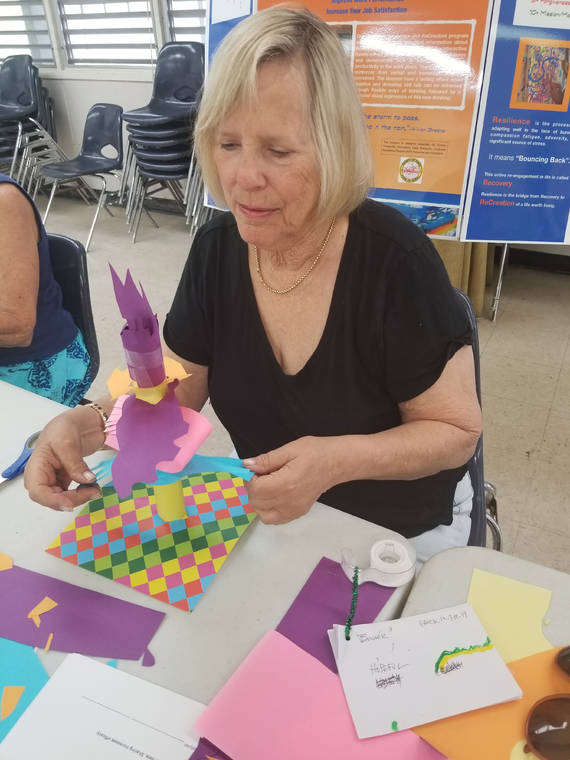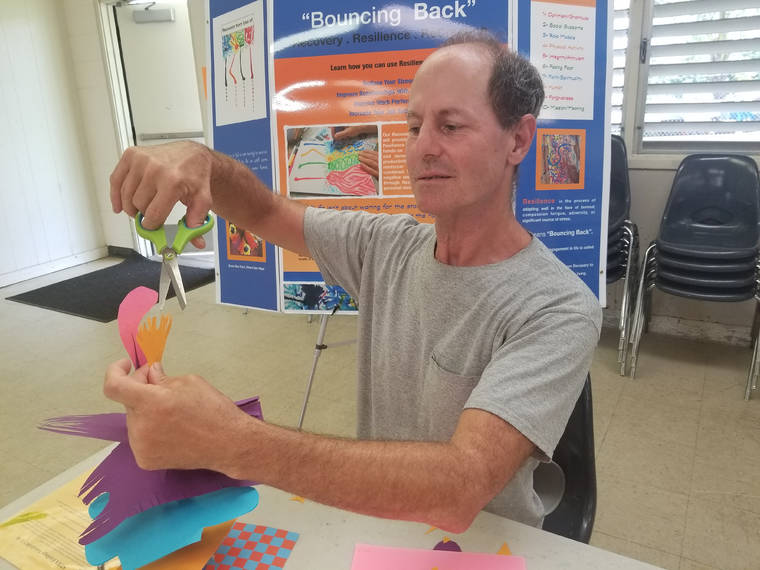Lava survivors use art to deal with stress
PAHOA — A small group of about 10 people gathered Thursday morning at the Pahoa Neighborhood Facility.
The room where they sat was warm and humid as participants — those still recovering from the 2018 eruption of Kilauea volcano in lower Puna — discussed their feelings.
Emotions ranged in their complexity and intensity. Designs cut out of paper provided a visual representation of how they felt.
One person was mellow. Another optimistic. Another was anxious and exuberant.
One woman had a neutral feeling, but “underneath there’s something but it’s not so much to give name to.”
Another woman seemed frustrated, although she used harsher language, but expected clarity to come throughout the session, as it often does.
They were participating in Bouncing Back, a 12-session program offered by Hilo-based nonprofit organization Self Discovery Through Art. Sessions are held weekly, and art and cognitive behavioral therapy techniques are used to aid individuals in their recovery from trauma caused by the eruption.
The program addresses four dimensions of recovery — home, health, purpose and community — and 10 resiliency factors and skills.
“What research has shown is these are general resilience factors and skills that people can build in order to move on, because you don’t really have a choice. You’re going to have to move on,” said Nidhi Chabora, a psychiatric nurse practitioner and therapist who started Self Discovery Through Art with N.J Moses.
She said, though, that individuals can make the choice to “remain stuck,” but that’s when psychiatric disorders begin to manifest.
“My job is to reduce the emotional distress in the community, so that there isn’t this overflow and the burden on health resources,” Chabora said.
Discussion on Thursday focused on integrity, one of the 10 resilience factors. Individuals identified and prioritized the values that were most important to them.
As the companion art project, the group created “integrity pillars,” and then “you hang your values on that pillar, and that’s what keeps you a stable personality, someone who’s dependable and trustworthy. So if you can depend on yourself, you’re going to get out of a hole that you had no control over.”
Participant Kazume Martin had to evacuate last year from her home in Black Sands because of the bad air quality caused by the eruption.
An artist, Martin said she has felt overwhelmed since the eruption, “like so much to do and just so overwhelmed by it all, and feeling like I didn’t have the energy to tackle it. So this (program) kind of helps me get past that ‘stuck-ness’ … getting past the overwhelmed, to move, to take those steps to move.”
The overwhelmed feeling has been difficult to deal with, she said.
“But, you know, things like this, where you can actually see yourself move forward, move out of a stuck place. It helps.”
Bouncing Back provides a healthy distraction from the constant thoughts of recovery, Martin said.
Part of doing the artwork is actually problem-solving, she said.
“But it’s not a conscious, mental whip. It’s more pleasurable. It’s medicine. Most of us are here every week because we feel such a difference at the end of the class. It is medicine. Art is medicine.”
When talking about overall recovery, Martin said she doesn’t “look at the whole thing,” but rather focuses on one thing at a time.
“Even if it takes me a week, at least I can get through it, and the more you see those little things stacking up, then you can feel like you’re coming back to being on top of things again.”
This is the third Bouncing Back series that has been hosted since the eruption, which ended nearly a year ago after destroying 716 homes and structures.
Chabora said the first began in August 2018, right after the lava flow stopped.
“We started at the Wailoa Center because we saw the need,” she said.
Kevin Kushel and his mother, Bunnie Kruger, have attended all three series.
Now living in Seaview, Kushel and Kruger lost their home in Vacationland during the eruption.
“When it happened last year, we were in a major crisis emotionally and our neighbors really constituted the first group,” Kushel said. The first Bouncing Back series “brought the community back together.”
The resilience techniques taught are helpful, too, he said.
“Then the art part really enhances the understanding of those things that Nidhi teaches in the first hour.”
The program provides predictability, Kushel said, “which is a nice thing. Still a year later, everything that I knew is gone. So to have something … that happens every week, builds more confidence in living again.”
“What I got out of it the first time … was seeing all the people that I had known in my community, who I hadn’t seen for a very long time after the lava. But then we regrouped down here,” Kruger said.
She also learned to “push on.”
“Keep pushing on, and I keep getting that out of each of these groups,” Kruger said. “Just push on.”
The classes also provide reinforcement.
“I always feel like I’m walking out a strong person,” she said. “And in each of the classes, I seem to measure myself to the other people and I seem to just have the ability to whether it’s the art, or just listening, to always push on.”
Overall, though, Kushel said the recovery process has been “progressive.”
“Every day I feel less rattled than last year at this time, and less tense. Things are more established …”
Email Stephanie Salmons at ssalmons@hawaiitribune-herald.com.



